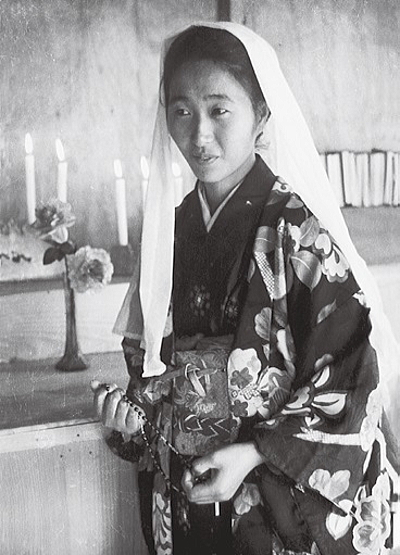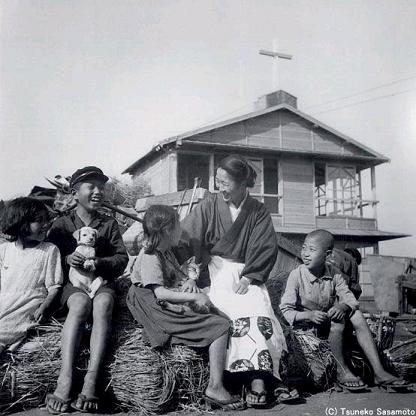By Br. Bernard Mary Fonkalsrud OFM Conv.
A descendant of samurai warriors and Shinto priests, Satoko Kitahara was born into an aristocratic Shinto household in Tokyo, Japan, on 22nd August, 1929.

At the outbreak of the Second World War, Satoko undertook her civic duty by working in an airplane warehouse with her brother for the good of the empire and the success of her countrymen. Air raid sirens were regularly being sounded, and the conditions in the warehouse were horrible, leaving Satoko suffering from tuberculosis and her brother dead from pneumonia. At wars end, like so many nationals, she was appalled at the revelation of atrocities committed by Japanese forces, leaving her disillusioned and believing that Shintoism offered her nothing.
After beginning her university studies in medicine, Satoko began to contemplate the deeper questions of life, and her place in the world; this was spurred on after a near death experience where she narrowly avoided being hit by a bus.
Along her route to university, she would often pass a number of churches and this would spark a sense of curiosity and intrigue, but she was always too shy and nervous to go inside. On a particularly providential afternoon, she noticed a man entering one of the churches, and she decided that she could wonder no longer – she entered the church of the Sacred Heart and, on seeing the statue of the Virgin Mary, later described how she was overwhelmed with an “indefinable emotion.” Satoko continued to visit this church and some others over time, eventually finding her spiritual home with the Mercedarian Sisters who provided her with catechesis and, despite the objections of her father, was baptized a Catholic on 30th October, 1949, taking the name Elizabeth, fittingly after St. Elizabeth of Hungary, who though royal, spent her life serving the poor and destitute as a Secular Franciscan.
With this newfound gift of faith, Satoko grew in a desire to give her entire self to God in Religious Life with the Mercedarian Sisters, but sadly due to her poor health she was not able to proceed with the formation. Despite the setback, she humbly accepted this cross and continued to strive for holiness in her day to day life, until one day she was surprised to encounter an unusual visitor to her sister’s store. Br. Zeno Zabrowski, a Polish Conventual Franciscan Friar, came to Japan in 1930 with St. Maximilian Kolbe. After the horrific destruction by the atomic bomb on the city of Nagasaki where he was based, Br. Zeno became renowned for his extraordinary humanitarian efforts in assisting the orphaned and displaced, receiving many national awards from Japan and Poland. In Tokyo, Br. Zeno had begun to minister to a community of impoverished people, known as ‘rag-pickers,’ who had taken up residence in the local dump site. Arinomachi, or ‘Ants Town,’ became a second home for Br. Zeno, who invited Satoko along to assist him in the ministry, helping to entertain the children with her piano skills, catechising and sharing the Gospel message, and offering comfort to the ill and dying. Eventually, Satoko renounced her wealth and status to adopt the life of a rag-picking ant. She was an inspiration to so many, including her own mother who would regularly come to assist in the community, that at her premature death from tuberculosis on 23rd January, 1958, thousands of people came to pay their respects to the ‘Mary of Ants Town,’ a true saint in their eyes.

For us today, Satoko Kitahara is a true witness of faith in action. The faith she received was not left to grow stale or stagnant, but rather it ignited within her a desire to serve the Lord in humility and love. She is a testament to the power of the Holy Spirit working in and through her simple “yes,” affecting the lives of all around her and inspiring others to come to faith in Jesus Christ themselves. She is a model for all neophytes, that the new shoots that spring up in the Church are called to continue to grow and flourish in the garden of the Lord.
The beatification process for Satoko Kitahara begun in 1972 under Archbishop Peter Seiichii of Tokyo, through the lobbying of the Conventual Franciscans. After the initial investigation into her life and virtues, the Congregation for the Cause of Saints declared Satoko a ‘Servant of God’ in 1981. As the investigations continued, Pope Francis confirmed Satoko Kitahara’s heroic virtues, and she was declared a Venerable in 2015. We continue to pray for her beatification and canonization.
Br. Bernard Mary Fonkalsrud OFM Conv.
Order of Friars Minor Conventual
Provincial Delegation of Our Lady Help of Christians, Australia
Mt. St. Francis Friary, Kellyville, NSW
First image is CC by 3.0 Ann Maria Clara; https://commons.wikimedia.org/wiki/File:Satoko_kitahara.jpg#/media/File:Satoko_kitahara.jpg
Second image is by Tsuneko Sasamoto, https://thetokyofiles.com/2016/08/23/satoko-kitahara-maria-of-ants-town/
